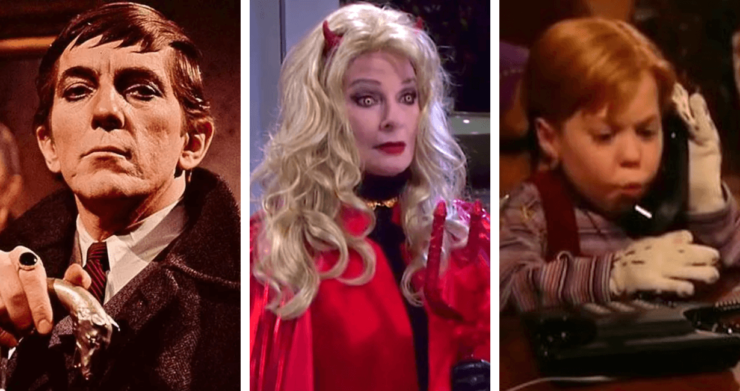You watch soap operas.
C’mon, you know you do.
Even if you don’t regularly tune into the four remaining daytime ones still in existence—Days of Our Lives, The Young and the Restless, The Bold and the Beautiful, or General Hospital—you still watch soap operas. Why? Because you are a genre fan. You love your grand, sweeping, dramatic, romantic, world-shaking science fiction or fantasy or horror films. You nitpick over who did what to whom and when and on what alternative timeline and who came back from the dead on shows like Game of Thrones or Star Trek. Or movie franchises like Star Wars or Harry Potter or Twilight or anything in the Marvel Comics or DC Comics universe. These entertainments bend their story to the breaking point and twist their plots it into pretzel logic…and we love it.
But wait, you may say: Star Wars and Game of Thrones aren’t like those soaps. They have big budgets. They have award-winning actors. They have prestige! And yes, it’s absolutely true: these days, what passes for soaps on TV often comes with a bigger budget, a smaller production schedule, and a whole lot of CGI. But the soap aesthetic is in the DNA.
All of which is to say that the actual daytime soap operas, the ones we watched—often with our grandmothers or moms (traditional soap watching habits tend to be matrilineal)—are inherently fantastic, even when they’re based in the most mundane elements of human existence: births, marriages, illnesses, sexual awakenings, deaths. Soaps prime viewers to believe in the elasticity of reality—that someone can forget she gave birth to a child, that someone can be dead for a decade and come back to life looking completely different, that the same couples can marry and divorce and marry and divorce ad infinitum.
So when soaps take that natural next step and race full-on into the fantasy, or science fiction, or horror universe, it may seem wacky but it never seems entirely out of place. And you might be surprised to find that some of the best remembered soap arcs often come wrapped around the beating heart of a genre story. Settle in, and let’s take a trip back in time to revisit some of the strangest, most unsettling, and utterly incredible SFF-fueled soap arcs of all time.
Barnabas the Vampire: Dark Shadows (1967-1971)
Not that soaps hadn’t dipped into the fantastical before Dark Shadows, but all modern vampire creations (soap or otherwise) that saw the light of day post-Dark Shadows owe everything to the moment Barnabas Collins’ coffin first opened.
The funny thing is that Dark Shadows—just one of eighteen soaps on the air when it premiered in 1965—didn’t start out as a vampire drama. A ghost named Josette appeared approximately 70 episodes in and made the ratings soar, so creator Dan Curtis decided to swing for the fences, introducing Barnabas (Jonathan Frid) in episode 211.
“I wanted to see exactly how much I could get away with,” Curtis told Cleveland.com in 2016. “I wanted to see how far I could go on the show into the supernatural, and I figured there was nothing more bizarre than a vampire. If it didn’t work, I figured we could always drive a stake into his heart.”
Barnabas was supposed to last six weeks, and then get staked. But the way he was written touched young Goth hearts of the 1960s: he was a vampire who questioned what his purpose was, not just some monstrous blood sucker who mindlessly went around flashing fangs. He was the proto-Edward Cullen, the pre-Vampire Lestat. He might not have a soul, but he sure was soulful. Without him, Buffy the Vampire Slayer, Underworld, Angel, and True Blood might never have seen the light of day (or night).
And Barnabas was just the tip of the iceberg for Dark Shadows—the show eventually introduced zombies, werewolves, a man who never aged, and a trip back in time by way of a séance. There wasn’t anything Dark Shadows wouldn’t do for ratings, and they did it all with relish (and a side of plasma).
The Lost Underground City of Eterna: One Life to Live (1989)
One Life to Live began in 1968 with the intent of focusing on racial and class divides, but by the 1980s that original earnest intent had drifted somewhat. By 1988 they’d sent a main character, Clint Buchanan, back in time 100 years to meet his ancestors; another main character, Viki Lord, visited Heaven three times (during her 2008 jaunt she met “The Creator,” embodied by series creator Agnes Nixon).
But when diving into OLTL’s genre storylines, one triumphs over all the rest: The discovery of the lost, gold-filled underground city of Eterna. Conveniently, it lay directly under Llantano Mountain near the town of Llanview, where all the characters resided. Who knew?! The show poured money into the creation of the largest set ever constructed for daytime series: a multi-level, 360-degree “city” built in a studio separate from the usual series headquarters. Real well-drillers were even hired to use the equipment needed to dig the characters out of the city at its conclusion.
The twisting, extended plot involved a baby that a teenage Viki had been hypnotized to forget she ever gave birth to; a hunt for legendary gold hidden in the city; multiple characters getting trapped underground thanks to an avalanche; and a convenient (as well as gigantic) TV screen that helpfully played videotapes to explain Eterna’s history. Booby traps set to prevent Eterna from being looted ensured the trapped characters were in a state of constant peril, and in the end a grab for a giant gold angel triggered the city’s self-destruct mode. Cue the well-drillers, who saved nearly everyone before the entire city went up in flames.
Marlena is Possessed (Twice!): Days of Our Lives (1995, 2021)
Possess me once, shame on me; possess me twice… well, you’re clearly visiting the town of Salem, as immortalized on Days of Our Lives. Even non-soap watchers can probably recall the time an actor on a soap opera levitated on camera because she’d been demon-possessed, Exorcist style. Not only that, the woman being possessed was one of the key figures on the series, played by one of the longest-serving actors in daytime: Deidre Hall, who as of 2022 had played Marlena in over 5,200 episodes.
So how did things come to this devilish pass for Marlena? Well, it all started when she became an object of obsession (a “Queen of the Night”) for the villainous Stefano DiMera. He gave her mind-altering drugs and hypnotized her so thoroughly that she became open to demonic possession and… well, when you leave a door open, anyone could just walk in. Marlena’s eyes changed color to glowing yellow-green, her personality changed completely and as the Devil began taking control, leading up to her immortal levitation trick on Christmas Eve (while everybody else was in church, peacefully singing “Silent Night”). Fortunately, a convenient priest named John Black (who she eventually married, when he was no longer a priest… it’s complicated) was able to perform an emergency exorcism the following year.
Fast forward to 2021, and the devil was back for a second try. This time Marlena welcomed the invasion—because she was able to save her pal Doug, who had been possessed first. See, Doug couldn’t handle the visitation, so the Devil gave Marlena the option to be taken over again. And she levitated for the second time! Clearly, this is a relationship she just can’t quit.
Tabitha Lenox the Witch: Passions (1999-2008)
Created and overseen by the delightfully lunatic soap opera veteran James E. Reilly (who conceived of the storyline for Marlena’s original possession on Days of Our Lives), Passions was a bonkers supernatural campfest carefully nested inside a traditional soap opera. Over the course of its 1,702 episodes, Passions featured musical numbers (everything from Bollywood to Chicago-inspired show tunes) and pop culture references galore.
But what really set the show apart was the decision to have Tabitha Lenox (that delightful meta-reference name!), a 300-year-old witch who apparently was responsible for the sinking of the Titanic, as a key character. Tabitha (Juliet Mills) didn’t just have one fantastical story arc—she had all of them. This was the era of Charmed and Buffy the Vampire Slayer, so supernatural happenings were expected to draw a younger crowd, which likely contributed to Tabitha getting the green light. Early on, Tabitha turned herself into a dog as part of an attempted murder; later on, she possessed the same target of her vengeful wrath, Charity Standish (a poisoned quiche was involved). When she had a child, she named her Endora (again with the Bewitched references), and the angel-faced girl quickly manifested her own magical abilities, including being able to summon her favorite musical act (Scissor Sisters).
But Tabitha’s most fantastical moment came when a life-sized doll she created called Timmy (Josh Ryan Evans) came to life. He was meant to help her out with her various schemes (particularly those directed against Charity), but Timmy turned out to be a rather good egg after all.
***
There are other great examples I could mention, but I’m sure everybody has their own favorite memorable moments when soaps and sci-fi, fantasy, and the supernatural collided. Please share your own in the comments below!
Buy the Book


Tune in Tomorrow
Randee Dawn is a Brooklyn-based entertainment journalist who scribbles about the glam world of entertainment by day, then spends her nights crafting wild worlds of fiction. Her debut novel, Tune in Tomorrow, about a fantastical TV reality show packed with soap opera-style twists, will publish in August (Solaris). She writes about the wacky world of show business for Variety, The Los Angeles Times, Emmy Magazine and Today.com and is the co-author of The Law & Order: Unofficial Companion. Find her on Facebook and Twitter, and RandeeDawn.com










